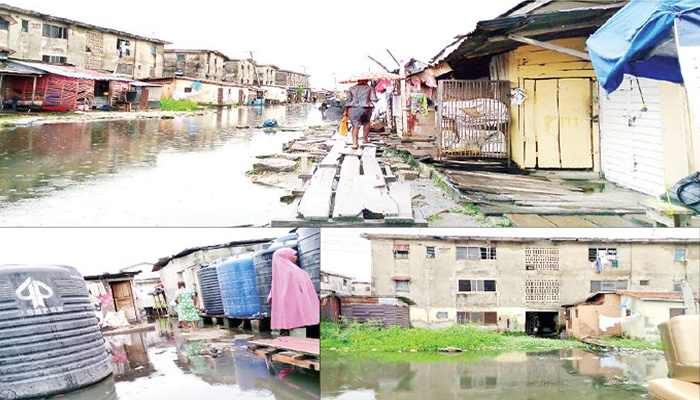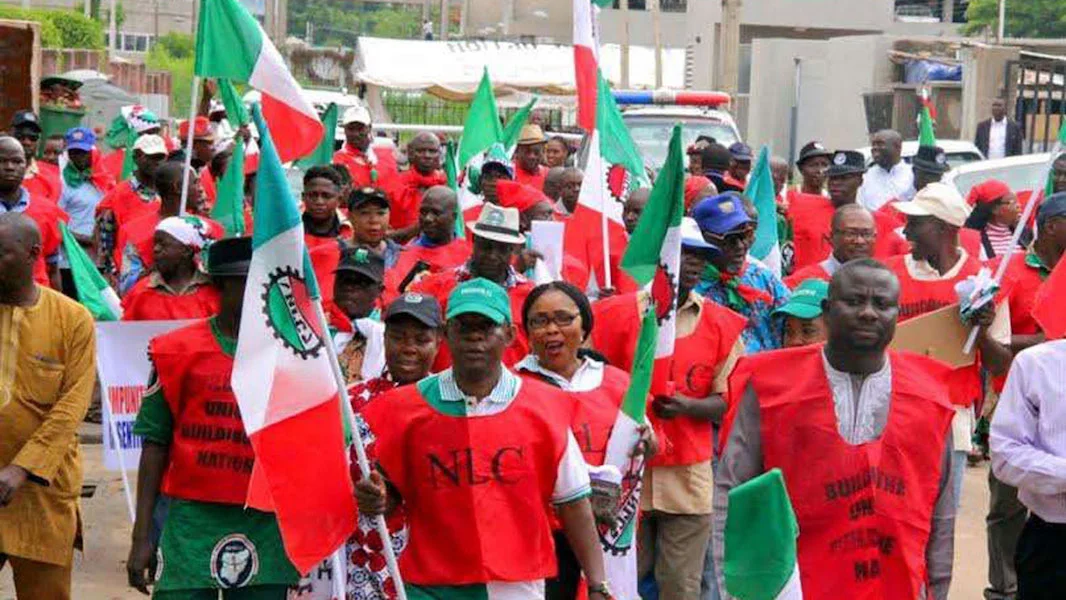Men, women, and children were seen in rain boots as they waded through dark-green-coloured water, much of which has not even dried up for about two years.
Floating on the water that covered many entrances to rooms, churches, and schools were spirogyra, sticks, nylons, and other materials.
The ‘stomach-swelling’ odour that reeks from the nooks and crannies of the vicinity, where two-storey buildings and make-shift apartments sit in stagnant water, could make a new person in the estate environment pass out.
“If you fall inside this water by any mistake, just ask to be taken to the hospital. Unfortunately, the hospital here probably has no space for you. You may have to get outside here for serious care,” a trader in the estate, Sunday Philip, who led our correspondent through the flooded footpaths around the buildings, jokingly said as he spat at intervals.
“Most of the water contains faeces; people defecate and throw inside gutters,” he added.
Coveted ‘small London,’ the legacy of a one-time visionary governor
Jakande Estate is part of the legacies of a former governor of Lagos State, Lateef Jakande, who served between 1979 and 1983. He was widely known for his infrastructural initiatives, one of the most popular being the low-cost housing estates.
Jakande’s government constructed over 30,000 housing units that were made available to low-income earners, including civil servants at affordable prices.
Some of the housing units are located in places like Oke-Afa, Abesan, and Lekki, just to mention a few.
Jakande, adjudged by beneficiaries to be visionary, was said to have funded these projects by increasing the tenement rates and price of plots of land in affluent areas of Victoria Island and Lekki Peninsula and the processing fees for lottery, pools, and gaming licences.
These estates were later named after the former governor by beneficiaries. Each is now being referred to as Jakande Estate.
Like most of the other estates, what was sometimes referred to as “small London,” according to a resident, and a much-coveted abode, the Jakande Estate at Ilasan, Lekki, is now squalor.
In its early days, most of the occupants of the estate were evicted from Maroko, a community in Eti-Osa in Lagos.
Adjacent to Ikoyi and East of Victoria Island, the then Maroko was a low-income area that attracted a lot of migrants due to its proximity to economically robust areas. Flooding and sand-filling affected Maroko during its life.
In the early 90s, military administrator, Raji Rasaki, evicted the residents and demolished the community. The government said Maroko was below sea level and needed to be filled in with sand.
Many of the evicted residents sought refuge in the Jakande Estate in Lekki as a form of compensation.
Four-decade buildings in decadence
Our correspondent visited the estate which has existed for about 40 years.
Entering from the Jakande first roundabout along the Lekki-Epe Expressway, it was the sight of refuse, littered around like sprinkled petals welcoming a guest.
At the mouth of the road is a market that extends from the estate, where traders tabled their goods on black-coloured soil surface, much of the characteristics of an age-long sedimentary deposition.
At the entrance of the estate, on the right side of the road, was a red-coloured gate that opened into a large expanse of land covered with sand. It is called ‘White Sand,’ and it is a landmark on its own. Opposite it is a block in the estate, where a banner pasted on the wall announced admission into a private secondary school, AnnyTina International Schools at blocks 232 & 255.
On the ‘White Sand’ land is a field where some youths were seen playing football. Right behind the field are heaps of refuse, and an isolated grassy area. Apart from the area reeking of fresh and stale faeces, the sight of it was not pleasant to start the journey into the estate with.
The buildings were old, with walls that could not be said to have been painted before. A new painting would have not helped the sights of the damaged roofs – in cases where they were not completely removed.
Whether some of these buildings would stand the test of another decade is a question that not even the residents, who feared eviction or demolition before then, could answer.
Jakande Estate, according to the Chairman of the Community Development Association in the area, Mr Kazeem Sulaiman, had about 1,900 housing units, but are now around 1,500 units because according to him, some of them had collapsed.
Old buildings like those in the estate have managed to stand strong to date when compared to new buildings that have collapsed in Lagos in recent times. This is perhaps due to the materials of those periods, which may now be different from those used for new structures in Nigeria.
Speaking on comparisons between the quality of building materials in the past and recent times, the National President of the the Nigerian Institution of Builders and Facility Management, Dr. Akinsola Olufemi, in a recent interview with The PUNCH, noted that the materials used in building construction in recent times were different from those used for building projects in the past.
“There was the Standard Organisation of Nigeria, which is still in existence, but they are not as functional as they were in the past. Also, there was the Standard Organisation of Nigeria Conformity Assessment Programme, which was always in the market to check if the materials and products were of good quality.”
Also, on the expiry date of buildings, a former President of the Nigerian Institute of Building, Kunle Awobodu, believes that the lifespan of a building should be up to 60 years.
According to Awobodu, in a recent interview with The PUNCH, he noted that theoretically, a building was assumed to have a lifespan of about 60 years, “however, looking at the age of Windsor Castle in London for instance, the castle has been there since 1070.
“Coming home to Nigeria, in some of the building surveys conducted by the Nigerian Institute of Building in 2020, it would be discovered that buildings like the water house owned by Candido Da Rocha on Lagos Island was constructed in 1874, and was still stable when we conducted a structural integrity test on it. In the same vein, Shitta-Bey Mosque on Martins Street, Lagos Island, was constructed in 1892.
“These buildings have been built well over 100 years and are still stable.”
Since buildings in Jakande Estate are around 40 years old, they might only need thorough renovation. But who will carry out this renovation or when it will be done are questions that beg for answers.
But the CDA chairman, Sulaiman, said total renovation of the buildings was a major request from them to the government, noting that nothing had been done for a long time.
“Renovation is what we’re seeking from the government. Complete renovation of the estate. We have been saying this for a very long time, but nothing has been done,” he told our correspondent.
Speaking on the fear of any of the buildings collapsing any time from now, he said the buildings were very dilapidated and it was highly possible for some of them to collapse.
“Ha! Dilapidated buildings. I would say 90 per cent of the buildings are dilapidated. There are some that can collapse on their own. We have their records like that. A lot of them are dilapidated,” he said.
Poor waste management
Our correspondent observed that refuse from the estate is not properly disposed of. At different locations in the estate, refuse is dumped indiscriminately.
The Lagos State Waste Management Authority spokesperson, Folashade Kadri, when contacted, queried the cooperation of the residents with the Private Sector Partnership agencies, that is, contractors under LAWMA in charge of removing wastes from households.
“If the operator was servicing them before and stopped, what went wrong? Were they paying and has there been any call to LAWMA customer care for backup service? You can only see LAWMA trucks in tenements when there is a complaint and LAWMA moves in to provide backup service. A lot of enlightenment has been done and is still ongoing on how tenements should manage their waste,” she told The PUNCH.
According to her, LAWMA is only responsible for removing waste in public places.
TITABABIF Nigeria Limited was the contractor servicing the Eti Osa West Local Government Area, Ilasan Orile where Jakande Estate is, according to information provided by LAWMA on the Lagos State government website.
When a call was put across to the phone number available on the website, the recipient said he was no longer in charge of the area.
CDA laments
However, the CDA chairman, Sulaiman, noted that part of the challenges encountered in the removal of waste was getting people to pay for it.
He noted that arrangements were made with LAWMA contractors at a time, but after they came about two times, the residents stopped seeing them.
“Truly, there was a time they came during which they met with the executives which I was also part of. We held a series of meetings concerning waste.
“It’s purely vulnerable people that stay here, and their demand (the waste contractors) was so high. So we called several people together to discuss the amount. But for the majority of them, their response was that it (LAWMA) is a government-owned agency and their money should not be so high. I can’t remember the amount as of then, but the money was just too high,” the chairman said.
“They (LAWMA) now said they could do it as ‘pay as you dump.’ We agreed on that and said we would try and see how it would work out.
“We notified everybody in the community. I think it was about N200 each, it depended on how your refuse was. They came for the first time, so we appointed a three-man committee that would go with them to see how it worked.
“They came for the second time and the third time they were to come, they said their vehicle was faulty. Since then, we have made several calls to them but to no avail,” Sulaiman added.
“We have one waste bin at the entrance of the estate, very close to the market. It’s been taken care of by the market workers (traders). It’s not enough because the estate is very big,” stated Sulaiman.
He said at the extreme back of the estate, there was another place where refuse was dumped and often burnt.
An environmentalist, Mayokun Iyaomolere, who spoke on the condition of waste management in the estate, noted that the condition was not acceptable, particularly in an estate.
“This is totally unacceptable for an estate. An estate should be more organised. Burning of waste is also a barbaric act. When they burn refuse, it affects their health, the plants, and animals in that environment, coupled with attendant climate issues. The estate should work with waste collectors. The refuse will definitely also block drainages,” Iyaomolere, who is the founder of Plogging Nigeria, a non-governmental organisation that trains youths in responsible waste handling and fitness, said.
Poor drainage
The lack of drainage in the Ilasan Jakande Estate has largely contributed to the stagnant water almost everywhere in the estate.
Our correspondent observed that right from the internal road outside the estate, poorly constructed drainages that “lead to nowhere” were rampant by the roadsides. Many gutters were blocked about 50 meters ahead of them, leaving a series of stagnant waters in them.
“Many of the drainages outside here lead to nowhere. Once it rains, they get filled up and the water overflows to the road or anywhere it finds including to the estate,” a resident, Sunday, told The PUNCH.
It was observed that either lack of drainages or poorly constructed ones with no headway, were dominant in the Lekki environment, including Ajah, and not just in and around the Jakande Estate.
Speaking on this, a resident, who gave his name as Peter Gologidi, said only landlords who had money were the ones that constructed drainages.
“It’s only landlords that have money that did gutters, the ones that don’t have left their houses like that,” Peter said.
The Lekki environment being a lowland area is highly prone to flooding due to its close proximity to the Atlantic Ocean.
For Peter, when the ocean is being encroached on due to construction activities, the water body is forced to areas like this, leaving helpless communities at the mercy of floods.
“Estates are continually built, even the Dangote refinery is a threat to the waters. These constructions on different sides of the water body push the water to communities like Ilasan where Jakande Estate is. It’s not only this area, many communities suffer from this, including estates in the Eleganza area in Ajah, and where there is no drainage, what will happen?” Peter queried.
Also addressing the drainage issue when interviewed, the CDA boss also said it had been a problem for a long time.
According to Sulaiman, the estate experiences flooding every year when it rains because of poor drainage.
He said the blockage of canals and gutters by refuse also contributed to the issue, and every year, the community had to write to the local government for intervention to remove the blockade.
“That has been happening for a very long time. There is no time we do not experience flooding when it’s the rainy season, because we don’t have a proper drainage system.
“When the rain is coming like this, we do write to the local government. And some of the gutters would have been blocked with refuse many times,” the CDA boss said.
He said, about a week ago, when he saw that the flooding was too much, he went around and realised that two gutters were blocked. He said he mobilised some men there to remove the blockade before the water began moving again.
“On the other side of the second gate, the one (gutter) at the roundabout was the one that was blocked completely. We can’t do that one ourselves other than to look for a caterpillar,” adds Sulaiman.
He said the community was still expecting the response of the local government on the matter at this time.
According to him, each year, when the community writes to the local government, they would bring an excavator to the place to remove the blockade.
Speaking on the planning in the Lekki environment and the drainage problem, a town planner, Moses Ogunleye, blamed it on the lack of an efficient system.
Ogunleye noted that, normally, when an environment was being planned, there should be provision for some important infrastructures, including drainage, apart from power supply and road, among others.
“But what we have had in Nigeria, particularly in Lagos or Lekki area, is that planning is chasing development.
“Because we don’t have infrastructures in place when developers or owners of the land now want to build, you will be forced to build and be looking for (unplanned) options to de-flood your area – to drain your community. Such cannot bring about an efficient drainage system.
“As you have rightly observed, the Lekki-Ajah-Jakande corridor is a low-land area. In some places, they’re even two meters below sea level. It’s a real challenge,” the planner said.
According to him, what Lagos has is what is called primary, secondary, and tertiary drainage, noting that tertiary drainage is to be taken care of by the local governments, “but I didn’t see any of that. Lagos State government should deal with secondary and primary channels (the lagoons, the big channels).”
Ogunleye said, “On the Lekki-Epe Expressway, you will see a secondary drainage, and off the secondary, you will see the channels, the rivers, and the sea. The big problem is that the system is not efficient because there are no drainages to take the volume of water. And the problem is very high now because of the amount of rainfall, and if the waters don’t go away, they become floods.
“Ordinarily, drainage should have been easy to de-flood because you have lowland areas – the seas where they could go, but because the government has not made an efficient system for tertiary drainage to be linked with secondary drainage and for secondary to be linked with primary drainage. Such is a big challenge, and we don’t even maintain the ones we have.”
Moving through the estate, our correspondent observed that worshippers, students, and teachers were not spared from the woes of the estate brought about by the poor drainage.
Stagnant water
Opposite Block 97 in the estate is the building of the Gospel Faith Mission International. Surrounding the church is stagnant water that has flowed to the church from the pool of water on the road opposite it.
Residents that were seen going into the church were wearing rain boots to prevent dipping their feet in the water.
Within the estate is also the Ilasan Primary School. The condition of the school seems to be more pathetic for the pupils, because, apart from overgrown grasses in the compound, right from the school gate, is a water-logged entrance that extends to the school compound. At the centre of the school blocks was a stagnant green-black colored water with some weeds raising their heads inside the pool of water.
Attempts to broadly capture the condition of the school were foiled when a woman who runs a store opposite the school gate challenged our correspondent and was beginning to make some calls. Our correspondent left the vicinity when the situation was becoming hostile.
But speaking generally on the stagnant water in the school and around other houses in the estate, a public health expert, Professor Tanimola Akande, said the condition was dangerous for the pupils and residents.
“The stagnant pool of water is unhealthy for any environment. Such a pool of water serves as a breeding ground for mosquitoes.
“People who live, work, or school around such places have frequent mosquito bites that lead to repeated episodes of malaria,” the Professor of Public Health at the University of Ilorin, and a Consultant Public Health Physician with the University of Ilorin Teaching Hospital, said.
Expressing fear of reptile attacks, Professor Tanimola added, “Reptiles such as snakes can also be in such stagnant water that may also bite humans,” saying “This can be very dangerous.”
Some of the residents also told our correspondent that one of the reasons they wore rain boots was to prevent germs from the water and any other dangerous organism in the water from getting to their feet.
Some planks usually doubled as bridges constructed as walk paths within the buildings in some sections of the estate. This is to prevent the dwellers from wading through the waters that have actually taken over the entrance to some of the buildings.
In some situations, if one is not a swimmer, the situation could be pathetic if one falls into the pool of water, especially children.
While passing through some of the buildings, a girl, around the age of seven years, fell while running with another little girl around three years old. They both fell near a pool of water on the ground before an adult helped both of them to get up. The situation would have been pathetic if they had both fallen into the water.
“There is no way we can enter our room without the wooden bridges,” a woman, who did not give her name but was seen spreading her clothes on the line with her feet inside the stagnant spirogyra-filled water that reached her knees,







2 Comments